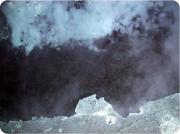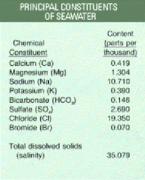Radio Program
Our regular Science and the SeaTM radio program presents marine science topics in an engaging two-minute story format. Our script writers gather ideas for the radio program from the University of Texas Marine Science Institute's researchers and from our very popular college class, Introduction to Oceanography, which we teach to hundreds of non-science majors at The University of Texas at Austin every year. Our radio programs are distributed at to commercial and public radio stations across the country.
The bottom of the sea is often described as “otherworldly.” It’s so different from what we see on land -- and so difficult to reach -- that it might as well be the surface of another planet.
But a pool of lava on the side of an undersea volcano takes the “otherworldly” business to a new level. It’s more like the volcanoes on one of the moons of Jupiter than those on Earth.
The male fiddler crab may be a show-off, but he’s also a gentlemen. He gives his burrow to his mate, and he never picks on a female.
Fiddlers are only an inch or two long. But they pack in close together, with thousands of them sharing the same territory in a mangrove forest or on a sandbar or mudflat. Each crab builds a burrow to protect itself against predators, and to provide a den for mating and incubating its eggs.
Most of us think of the ocean depths as dark and silent -- like a giant sensory deprivation tank. But while they’re certainly dark enough, they’re not silent. Sound has no trouble traveling through the oceans. In fact, it travels much faster than it does in the air -- and a lot farther.
Because water is denser than air, sound waves ripple through the oceans almost five times faster than through the air -- almost a mile per second.
But the speed can vary by a couple of hundred miles an hour. It travels faster through warmer water and through greater pressure.
Abalone is popular all around the Pacific Rim, from Santiago to Tokyo. It’s expensive, though, because abalone populations have plummeted in the last few decades, mainly because of overfishing.
The abalone is a type of sea snail. It has a tough spiral shell that’s shaped a little like an ear. It moves around on a large muscle known as a “foot” that sticks out of the bottom of the shell. Tentacles around the foot poke around for food or signs of predators. A full-grown abalone is a few inches across, and some can live for several decades.
Hurricane season opens on June 1st, so we’ll soon hear lots of talk about categories and wind speeds -- numbers that coastal residents ignore at their own peril.
When a tropical system first gets organized, it’s called a tropical depression. It’s not likely to cause much damage if it hits land. Once winds hit 39 miles per hour, it’s upgraded to a tropical storm, and it’s given a name. This year’s list of names begins with Ana.
The great white shark may be one of the most feared creatures in the oceans, but it’s also one of the most beautiful. Its long, streamlined body is both powerful and graceful. But the great white’s cousin, the great hammerhead shark, looks anything but graceful. Instead, it looks like something dreamed up by a mad scientist, with some sort of odd tool attached to a shark’s body.
Water, water everywhere -- and not a drop to drink. That’s a key plot point in any tale of survival at sea. Even though the heroes are floating atop an ocean, they can’t drink the water because it’s too salty.
Seawater is about 200 times saltier than freshwater. You’d have to stir a teaspoonful of table salt into a glass of tap water to equal the salt content of the oceans.
Ocean “salt” contains a variety of chemical elements. Sodium and chloride -- the ingredients of common table salt -- account for almost 90 percent of these dissolved elements.
A jellyfish that’s found in the Pacific Northwest seems simple enough. Known as Aequorea victoria, it’s only a few inches across, and it doesn’t sting, so you can float right through it without harm.
Yet a substance that’s produced by the jellyfish has become one of the most remarkable tools in modern medicine and biology -- a tool that earned three scientists last year’s Nobel Prize for chemistry.
The substance is known as GFP -- green fluorescent protein. It produces a faint ring of green light around the rim of the jellyfish’s “umbrella.”
A century and a half ago, biologists got a shock when technicians raised a section of telegraph cable from the bottom of the Mediterranean Sea. The cable had been resting at a depth of more than a mile, where scientists expected to find little or no life. Yet the cable was covered with life: corals, mollusks, worms, and a host of other organisms.
Telegraph cables were responsible for many discoveries about the ocean floor -- from its depth and contours to how it changes.
A tiny fish that’s common in the western Pacific sounds like the James Dean of the oceans: it lives fast and dies young. Known as the pygmy goby, it lives no longer than two months -- a shorter lifespan than that of any other fish.
The pygmy is one of perhaps 2,000 goby species. Some can grow up to two feet long. But the adult pygmy goby measures only about half an inch.




